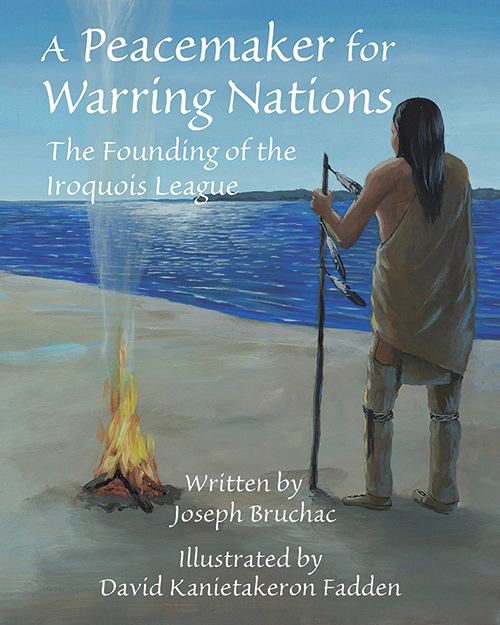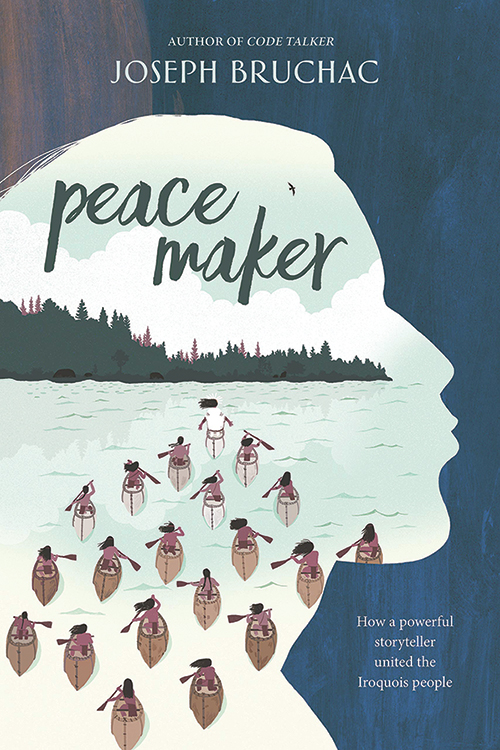
A Peacemaker for Warring Nations: The Founding of the Iroquois League AND Peacemaker
Reviewed by Paul Buckley
December 1, 2021
By Joseph Bruchac, illustrated by David Kanietakeron Fadden. Wisdom Tales, 2021. 56 pages. $18.95/hardcover; $9.99/eBook. Friends Journal recommends for grades 4–9.

By Joseph Bruchac. Dial Books for Young Readers, 2021. 160 pages. $16.99/hardcover; $7.99/paperback (available in January 2022); $9.99/eBook. Friends Journal recommends for grades 8–12.
Joseph Bruchac is an incredibly prolific author. The following is from his website:
For over forty years Joseph Bruchac has been creating literature and music that reflect his indigenous heritage and traditions. He is a proud Nulhegan Abenaki citizen and respected elder among his people. He is the author of more than 120 books for children and adults. His best selling Keepers of the Earth: Native American Stories and Environmental Activities for Children series, with its remarkable integration of science and folklore, continue to receive critical acclaim and to be used in classrooms throughout the country.
This year Bruchac has written two books about an important Iroquois individual named Skennerahowi, the Peacemaker. One is a book with large full-color illustrations around blocks of text and the second, a middle grade novel. The first book is focused on the Peacemaker himself. Words in Iroquoian languages are used throughout and, although it is set in the Lake Ontario region, this is a foreign land to most of us. The story takes place well before the arrival of Europeans, telling about people who lived lives largely untouched by outside cultures, and as such, based on different assumptions about how people relate to each other. It challenged me to set aside my usual expectations as a reader and open myself to ways of thinking and acting that might seem familiar but, in fact, were not. Perhaps children, who don’t carry my years of acculturation, may have an easier time doing so.
The Peacemaker is a historic figure who all people in the United States, especially those who consider themselves pacifists, should know. According to the traditions of his people, he was a messenger sent by the Creator to remind the people “to treat all things with respect, to always give thanks for the many gifts of life . . . to bring back balance and peace.” In this way, he was akin to the many prophets who have been divinely guided to call an apostate people back to faithfulness.
According to tradition, he was born to a virgin and resurrected several times over the course of a life spent spreading a message of peace, harmony, and equality—both within and between the various communities in the five nations that were to make up the Iroquois or Haudenosaunee League. As a result of his work, a confederation was born: one led not by the old war chiefs, but by royaners—peace chiefs who were named by the women in each community.
This work was not readily accomplished. The message was not easily delivered nor easily received. On hearing it, one chief said, “I like your message . . . but I do not think it will work.” Reading these words brought to mind many conversations I have been in. The Peacemaker modeled humility, courage, perseverance, and the willingness to risk everything in fulfilling the mission he was called to. We adults need to remind ourselves that these are lessons to be practiced as well as taught.
This is not a book that most children will be able to peruse on their own, but it is well suited for one (or preferably several) First-day school lessons. Adult leaders would do well to spend time acquainting themselves with the book: learning how to pronounce the Iroquoian words, and also reading related material. The parallels to Judaism, Christianity, and other spiritual traditions are obvious, and the fact that they arose independently in cultures isolated from one another bears consideration. For Friends, the resemblances of the Peacemaker’s message to Quaker testimonies are immediately striking. In addition, this book can be used as an invitation to discussions about what it means to be divinely called and the costs that faithfully responding to a call can bring.
This is a book for a wide age range. Students in elementary school might enjoy reading this book (or having it read to them by an adult); teens and even adults will also find it worthwhile.
Before moving on to the second book, I must mention David Kanietakeron Fadden’s glorious illustrations. They depict people who are proud, self-assured, and sometimes sad or scared, while living in an unspoiled land of forests, lakes, hills, and marshes. Each individual’s unique character and personality comes to light in his pictures.
Bruchac’s second book, Peacemaker, is an adventure story centered on a 12-year-old boy named Okwaho. In the opening chapter, Okwaho’s best friend is kidnapped by raiders from another tribal nation, while he was able to get away. The first half of the book focuses on how a boy on the threshold of adolescence deals with the guilt he feels for escaping capture, his personal desire for revenge, and how his community reacts to the event. His village was established by 14 families who hoped that by withdrawing from their home community, they could build a safe space away from the endless raiding, retaliation, and intercommunal warfare that plagued the settlements south of Lake Ontario. The kidnapping of one of their children threatened to draw them back into the fighting. No safe alternative seemed possible. Even returning to their former homes would result in humiliation and suffering.
In the midst of this crisis, the Peacemaker appears, carrying another option. Rather than re-entering the cycles of violence or attempting once again to run and hide, he calls on the five Haudenosaunee nations to bind themselves in a peaceful confederacy. The second half of the book recounts how the trajectory of Okwaho’s life is altered by this intervention and how the power of stories and song can change the course of history.
Constantly lurking in the background is the question of whether a message of peace can overcome entrenched cultural assumptions and institutional power. Repeatedly, the Peacemaker’s courage and steadfastness meet the challenge. He ultimately succeeds by faithfully modeling the message the Creator has given him.
Both books call for activism in the face of fatalism, cynicism, and oppression: do what you are called to do, and trust that even that which seems impossible can be achieved. They can revitalize our sense of how far faithfulness can take us. This is a message for young and old alike.
Paul Buckley has recently returned to Richmond, Ind., where he worships with Clear Creek Meeting. Paul is the author of numerous articles and books on Quaker history, faith, and practice. His most recent book is Primitive Quakerism Revived: Living as Friends in the Twenty-First Century.


